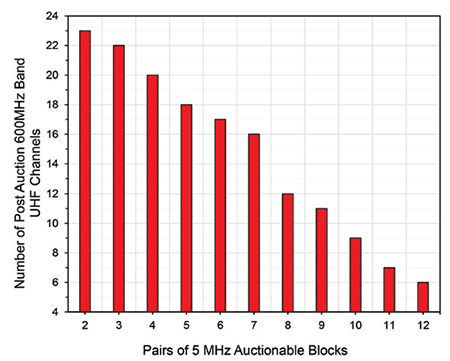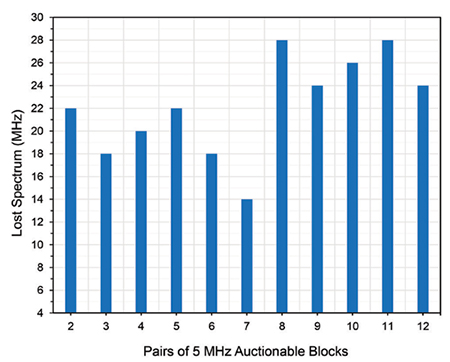Eleven FCC Scenarios for The 600 MHz Band Plan

Charles W. Rhodes The FCC is proposing 11 scenarios for a 600 MHz Band Plan following the spectrum auctions. Which of these will be adopted will be determined by the outcome of the auction in 2016.
Each scenario for the 600 MHz band starts with Channel 21 (512–518 MHz). The highest channel number ranges from 26 to 44, depending on how much spectrum is offered for sale by broadcasters and then resold to broadband operators. The re-allocated spectrum is divided into blocks of 5 MHz each. There could be from two to 12 pairs of blocks. Pairs consist of one block for uplink transmissions from cellphones to base stations; and a second for downlink transmission by base stations to cellphones.
INTER-SERVICE INTERFERENCE
I have restructured the data in Fig. 1 into Figs. 2 and 3. Fig. 2 shows the number of UHF TV channels after repacking. It varies from 6 to 23 depending on how many pairs of 5 MHz blocks are re-allocated after the auction.

Fig. 1: The graph is Fig. 23 of the FCC's June 2 R&O, page 453. Light Blue: 5 MHz blocks of spectrum. Orange: Channel 37 reserved for radio astronomy and medical telemetry (hospitals). Diagonally shaded gray: guard bands. Blocks with numbers from 21–36 and 38–44 should be tinted light green. These are the remaining DTV channels. The numbers in a column on the left side are the amounts of spectrum broadcasters might offer to sell. The amount of spectrum that can be re-sold to broadband is less due to the need for guard bands in the 600 MHz band.
In Fig. 1, the striped cells with numbers of MHz; 11, 9, 7 or 3 represent the guard bands. There is an 11 MHz-wide guard band between the cellphone uplink blocks and the base station downlink blocks. There are also some smaller guard bands, notably, a 3 MHz-wide one adjacent to Channel 37; and a 7 MHz-wide guard band between some base station transmit blocks and DTV channels.
These guard bands are vital to protecting against what the FCC calls “Inter-Service Interference” or ISIX. Broadcasters are familiar with the fact that a DTV transmitter radiates power in both channels adjacent to the channel it is licensed to use. This is sometimes called sideband splatter, but it is actually third-order inter-modulation products generated in the high-power amplifier of a DTV transmitter; which gets past the transmitter RF mask filter and is radiated.
The 3 MHz guard bands on either side of Channel 37 (608-614 MHz), which is reserved for radio astronomy and medical telemetry, protect that channel from ISIX. The total bandwidth of all guard bands varies among the 11 FCC scenarios from 14 MHz to 28 MHz. I call such spectrum “lost” because, by definition, it cannot be used either by broadcasters or sold to broadband. Such spectrum is also lost as a source of revenue to the U.S. Treasury Department.

Fig. 2: Number of DTV channels after repacking as a function of the number of pairs of 5 MHz blocks available for auction.BEST LAID PLANS
I expect there will be pressure by white space advocates to let these guard bands also be used for white space services. That scares me because I recall the “good ol’ days” of Citizen’s Band mobile radios. Chaos soon reigned in the CB Band.
If the FCC chooses either eight or 11 pairs of 5 MHz blocks, it will have to purchase 28 MHz more spectrum from broadcasters than it will be able to resell to broadband operators. Since the commission is mandated not to lose money in these auctions, it will have to resell this spectrum at a price well above what it paid for the spectrum it purchased from broadcasters.
The 2012 law that authorized this auction requires the FCC to recover all costs of conducting it and requires the commission to turn over to the U.S. Treasury the net profits. I believe some of the billions of dollars expected from this spectrum auction will never be realized. I suspect that the estimated $44 billion of auction proceeds do not take into account the fact that some spectrum the FCC will buy cannot be resold because it must be used as guard intervals in the 600 MHz band plan.
The best case scenario from this perspective would have the FCC buy 84 MHz of spectrum and to resell 70 MHz of this spectrum. The minimum markup would be 84/70 or 20 percent. Administrative costs, the $1.75 billion to reimburse displaced broadcasters, and the profit for the U.S. Treasury will erode those billions of dollars promised to Congress.

Fig. 3: “Lost UHF Band Spectrum” in MHz. as a function of the number of pairs of 5 MHz blocks available for auction. Note the steep increase in “Lost Spectrum” between 7 pairs and 8 pairs of 5 MHz auctionable blocks. Fig. 3 plots the number of DTV channels in the 600 MHz band after repacking as a function of the number of pairs of 5 MHz blocks auctioned by the FCC. The outstanding feature of this plot is the steep decline in the number of DTV channels between the scenario with seven pairs of 5 MHz blocks (16 DTV channels) and the scenario with eight pairs of 5 MHz blocks. It would cost broadcasters four channels to allow one additional pair of 5 MHz blocks instead of seven pairs.
When all is said, it appears the best scenario identified by the FCC would provide seven pairs of 5 MHz blocks. This view has also been expressed by a number of cellphone operators according to the FCC.
CELLPHONE DESIGN
The FCC report provides a very complete analysis of each of the 11 scenarios depicted in Fig. 1 (FCC 14–50, p. 453). As Fig. 1 shows, there are guard bands of 3, 7, 9 and 11 MHz between different kinds or signals. The 11 MHz guard bands between uplink and downlink signals are obviously needed to keep the transmitter output from getting into the receiver input. The others are also required to avoid third-order distortion products from causing interference. For example, the 3 MHz band stop filters keep received signals in Channels 36 or 38 out of Channel 37.
Every kind of filter attenuates every signal within its pass band (insertion loss). With each 1 dB of insertion loss, the receiver’s noise figure increases by 1 dB, and sensitivity decreases by 1 dB. Worse yet, where there is more than one filter in the signal path, the insertion loss of each filter is additive. In Fig. 1, you will see that each scenario requires at least one 11 MHz filter and some require two or three filters. Filters not only cost in receiver performance, they cannot be manufactured as an integrated circuit so they take up space and add slightly to the weight of handheld cellphones. The fewer the number of filters in a handheld cellphone, the less it will cost and weigh, all things cellphone users can appreciate. As Fig. 1 shows, the number of filters varies significantly for the various scenarios.
There is yet another variable of importance not shown in Fig. 1, but was covered in the FCC report. The bandwidth over which the antenna of a handheld cellphone is efficient varies between the scenarios in the FCC Plan for the 600 MHz Band. Antenna efficiency directly affects battery life (time between recharges), as well as the sensitivity of the receiver. Scenarios that provide more than eight pairs of 5 MHz blocks will involve these antenna bandwidth problems. Where the efficiency of a simple passive antenna is poor (lots of signal bandwidth), the antenna can be automatically tuned to improve its efficiency. However this automatic antenna tuner feature requires added circuitry and therefore adds to the manufacturing cost. The insertion loss of this reduces the power to the antenna, which translates to increased power drain on the battery when transmitting. When receiving, it adds desensitization of the received signal.
Stay tuned.
Charles Rhodes is a consultant in the field of television broadcast technologies and planning. He can be reached via email atcwr@bootit.com.
Get the TV Tech Newsletter
The professional video industry's #1 source for news, trends and product and tech information. Sign up below.
